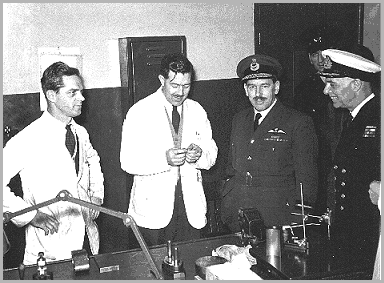
The Visitor 4
Large number of presses
The other basic process of watch manufacture, pressing, is carried out on a group of presses of several types and of very different sizes. Some, indeed, seem surprisingly large for work on watch components. These produce the rough blanks from which the main plates are made.
(Left to Right) Mr J. Turley (Toolroom engineer), Mr J.A. Delany (Asst. Works Manager), and (4th from left) Mr Howard Griffiths (Security) with visitors from the Imperial Defence College.

One of the most fascinating processes in the whole work of production at Gurnos works is "recessing" - the cutting of sinks in the main plate blanks to accommodate the train and other parts. After pressing, the plate blanks are shaved on both faces to give a smooth, even surface, and then they pass to the recessing machine. This is a very fine example of modern technique, for it carries out at one time, and in one setting of the blank, work that formerly required much individual setting up of the watch plate. On recessing machines, two blanks are set up on two identical heads on the machine, being located by the working holes. They are clamped, and the machine starts up. By means of two single-point tungsten-carbide tools, which are really tiny end-milling cutters, one for each blank, metal is rapidly cut away to provide the sinks and recesses needed, each sink or recess being of exactly the right dimensions and depth. The cutter, revolving at high speed, moves about in a most astonishing manner, now moving in to cut a deeper recess, now following a complex path as it produces some necessary "elbow room" for a future component, and finally, when all the cuts are completed, coming to rest automatically. The action of the cutter is guided by accurately shaped cams, whilst the depth of the cuts is determined by micrometer stops. The machine can even be made to cut a perfectly round hole, or to leave a round peg that is as precise as if it had been turned, just by suitable shaping of the controlling cams. Added to all this, the finish left by the cutter is equal to any obtained by turning.
The next process that the plate encounters is most important - the centre dotting of the holes that will later carry pivots, screws, steady-pins, and so on. In fact, the whole accuracy of the future movement is decided at this stage. Again from a location given by the two holes in the extremities of the rough plate, the dots are indented by a tool of extreme accuracy. Each of the dotting points is precise in position to a tiny fraction of a millimetre, and, as there may be dozens of them, the setting out of every separate point with the necessary accuracy and the subsequent maintenance of that accuracy during the working life of the tool, call for workmanship of the greatest precision.
After centre-dotting, the holes for pivots, steady-pins, and similar items are drilled on sensitive drilling machines, operated by girls whose deft fingers apply the exact pressure to produce a perfect hole. How skilled these girls are is shown by the fact that, although the drills are so small, they hardly ever seem to break one. Other drilling and tapping operations are carried out on automatic machines, and some holes which will later have jewel-holes pressed into them are drilled slightly under-size, and then enlarged to their final diameter by precise press-tools of the shaving type.